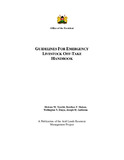| dc.description.abstract | Kenya’s agricultural sector accounts for 20–30% of the gross domestic product (GDP). Of this, the livestock sector alone makes a contribution of about 50%. Thus, livestock contributes heavily to the GDP and food security of its population. It also provides the necessary thrust for other forms of development in the country. Recent statistics indicate that currently over 50% of the country’s livestock population is based in the arid and semi-arid lands (ASALs), which form about 80% of the country’s land area. However, comparative international statistics show that livestock contributes 88% of the total agricultural output in Botswana even though the country has half Kenya’s livestock population and is of less agricultural potential. Thus, there is a huge potential contribution that livestock can make to the Kenyan national economy. Unfortunately, this sector receives only 10% of the government’s agricultural expenditure and less than one per cent of total spending, yet it is estimated that Kenya’s potential to export livestock products if adequately exploited would earn more than the earnings from tea and coffee combined. This then calls for new thinking about livestock development strategies to harness the arid lands | en_US |

